Many people are familiar with cable ties (aka “zip ties”), the nylon strips that are designed with an open-cased ratchet on one end through which the free end can be pulled to the desired location on its built-in gear rack.
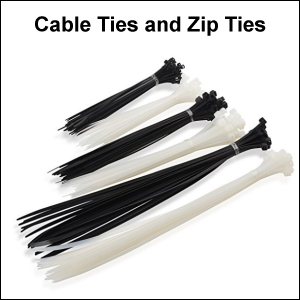 We kept a supply of them in the trucks we drove long haul or regionally.
We kept a supply of them in the trucks we drove long haul or regionally.
When Mike became a local truck driver, he didn’t need them as often as he used to.
However, local drivers who haul containers may require them much more often.
Since the ratchet prevents the tie from slipping backwards, it can only be pulled tighter (unless the ratchet is manipulated).
This “one-way” feature generally makes them single-use devices.
Note: opening the ratchet to release it makes the tie weaker.
Advantages
When it comes to fastening things together, cable ties have many advantages.
They are:
- easy to use;
- lightweight; and
- strong (up to the loop tensile strength).
Furthermore, they come in a variety of widths, lengths and thicknesses, and have other variations suitable to fit applications and situations.
Before You Buy
Suppose that you were in the market to buy a bag or bundle of these handy devices.
Your needs would differ depending on your uses.
If the situations where you would be using them are always the same, then buying a single size will work.
If your situations vary, you would be wise to consider a variety pack.
Consider the following types of specifications before you make your purchase:
- material (usually nylon although some can be metal),
- length,
- width,
- thickness,
- color,
- tensile strength (also called “loop tensile strength”),
- operating temperatures (max and min),
- various resistances (such as U.V. resistance),
- number per bundle or bag, and
- single use or multi-use applications.
If you think that you need a fastener that you can use multiple times, then your better choice might be something like Velcro, not a cable tie.
However, a zip tie is such an inexpensive option that you might be able to discard an old one and install a new one (if the replacement doesn’t need to be made too often).
An In-Truck Use
An irritating situation presented itself in the truck that Mike once drove for his trucking company.
The cargo net that was installed to keep things from falling out of the overhead storage compartment (over the driver’s head)
- stretched from side to side and
- was supposed to be fastened over the knobs along the interior of the compartment.
This overhead storage compartment was where Mike stored materials such as his aluminum forms holder, truckers atlas and exit guide.
His frequent movement of these items into and out of the compartment was sufficient to work the cargo net off the knobs.
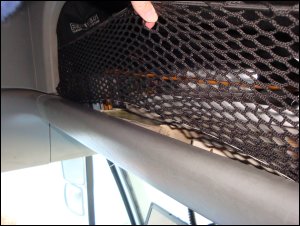 In this photo, you can see Vicki holding up the cargo net which had come off the knobs (despite having been attached to the knobs numerous times and despite having had dental floss strung through it to anchor it).
In this photo, you can see Vicki holding up the cargo net which had come off the knobs (despite having been attached to the knobs numerous times and despite having had dental floss strung through it to anchor it).
Without the net in place while the truck was in motion, items stored in this compartment could come crashing down on the driver and passenger!
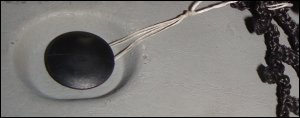 Vicki had tried to anchor the cargo net to the knobs with dental floss (which she considers stronger than regular thread).
Vicki had tried to anchor the cargo net to the knobs with dental floss (which she considers stronger than regular thread).
But the awkwardness of looping the floss over the knobs and trying to get it to stay in place rendered it practically useless.
Enter the idea of using a small cable tie to firmly (and hopefully once and for all) affix the cargo net to the knobs in the storage compartment.
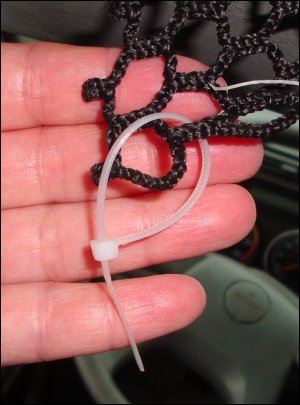 Vicki used a bunch of small cable ties for this job. You can easily see how she ran the free end through the cargo net and then through the ratchet.
Vicki used a bunch of small cable ties for this job. You can easily see how she ran the free end through the cargo net and then through the ratchet.
Vicki held her hand behind the cargo net so that you can see where (near the end) she chose to install the cable tie.
Instead of putting it on the very end (with only one thickness of netting material), she chose to put it through the net where there were two thicknesses.
She ended up looping the nylon strips through the net’s double-thickness segments for each knob all along the entire length of the storage compartment.
 In this photo, the cable tie is shown loosely looped over the knob and ready to be firmly attached.
In this photo, the cable tie is shown loosely looped over the knob and ready to be firmly attached.
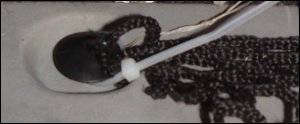 In this photo, the cable tie has been tightened around the knob, probably never to be removed again.
In this photo, the cable tie has been tightened around the knob, probably never to be removed again.
Once Vicki fixed the cargo net in Mike’s truck using cable ties, we never again experienced problems with trucking materials falling out on us from between the net and the storage compartment.
We strongly recommend the use of these devices where it is appropriate.
Container Tie Downs
Since containers are held onto their chassis via tie downs, and since the tie downs are subject to shifting, we have seen where drivers have used cable ties to keep them in place, like the following photos show.
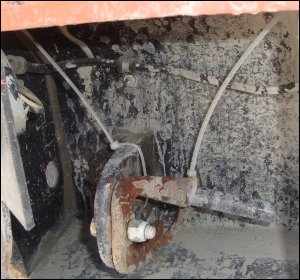 Here, two cable ties anchor the tie down on the corner of a container chassis.
Here, two cable ties anchor the tie down on the corner of a container chassis.
You never want for the tie downs to vibrate out of place and the container to fall off the top of the chassis.
A container coming off its chassis will damage the container, whatever is in it, whatever it lands on, and require the equipment to pick it up and haul it off.
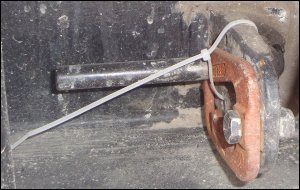 Here, one cable tie secures a tie down on the corner of a container mounted on a chassis.
Here, one cable tie secures a tie down on the corner of a container mounted on a chassis.
Incidentally, we were never taught in truck driver training school or by our first trucking company how to secure a container on a chassis.
One time, we almost lost a container off a chassis coming out of a port near Seattle, WA.
Reusable Cable Ties
Since originally publishing this page, we have learned that there is a product called Velcro Reusable Self-Gripping Cable Ties.
We would be interested in learning from drivers if these have the same strength as regular plastic ties.
For one thing, these are advertised to be reusable. You may wish to use them in applications where re-usability is important.
Where to Buy Cable Ties
Cable ties may be purchased in many stores, many truck stops, and through Amazon.com, with which we have an affiliate relationship.
![]() Money saving tip: Cable ties are sturdy and inexpensive fastening solutions that can be used in appropriate situations.
Money saving tip: Cable ties are sturdy and inexpensive fastening solutions that can be used in appropriate situations.
They can be found in most hardware and home improvement stores.
If you anticipate that you might need them in a variety of situations, consider buying a variety pack containing different lengths, widths and thicknesses.
Sometimes, the larger the bundle or bag you buy, the less expensive they are individually. However, to get your money’s worth, they have to work in the situations that you will encounter. There is no sense in buying a large quantity (no matter how good a buy they are) when they won’t work where and when you need them to.
If you find that the strength and width of a zip tie is suitable but the length lacking, you may “chain” two or more ties together to form a longer loop.
Depending on the need, you may need to be careful on what side of the loop chained ratchets will appear.
Once the end of a cable tie has been pulled through the ratchet, it may be cut off in line with the ratchet so that there is no “tail” hanging loose. The resulting cut end may be sharp, so please take appropriate care.
Note to truckers with pets with them on the road: Be careful about using these products with any living thing.
Return from Cable Ties and Zip Ties: Inexpensive, Sturdy Fastening Solutions to our Tools and Equipment page or our Truck Drivers Money Saving Tips home page.









